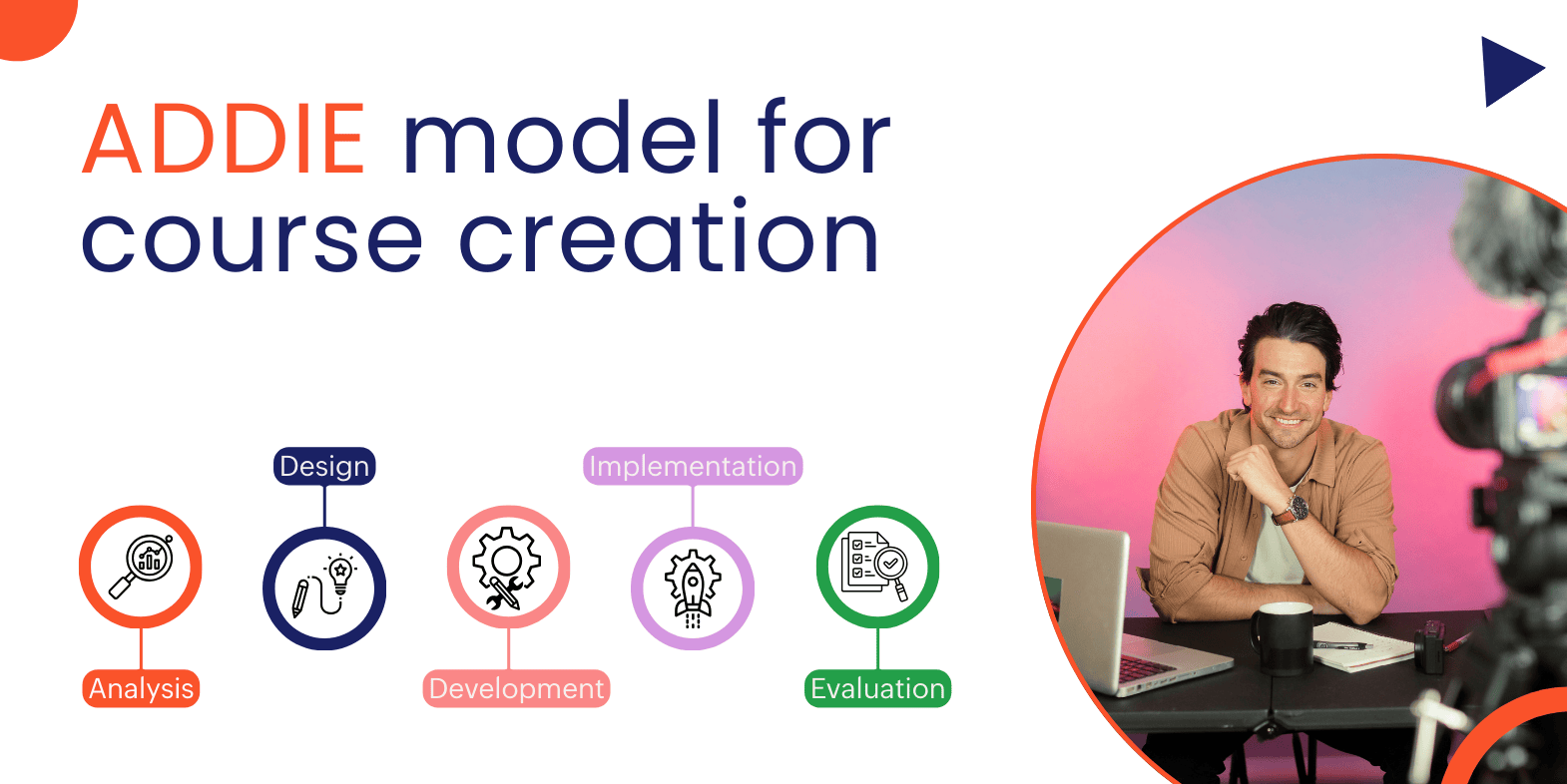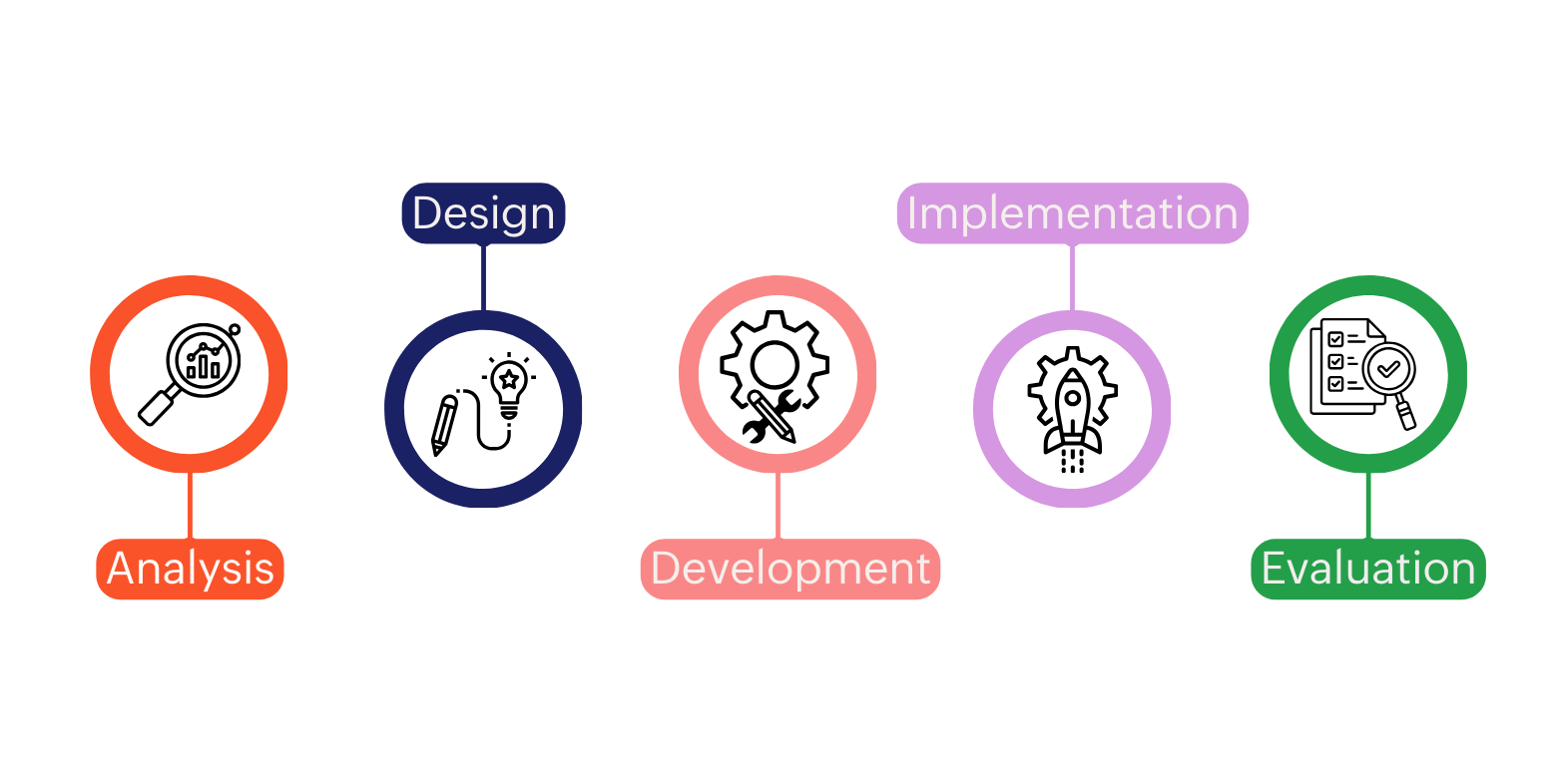- HOME
- E-Learning trends
- What is the ADDIE model, and why is it essential for course creators and corporate training programs?
What is the ADDIE model, and why is it essential for course creators and corporate training programs?
- Last Updated : April 9, 2025
- 46 Views
- 7 Min Read

Creating a course that truly connects with learners involves more than just transferring knowledge. It requires thoughtful planning, structured execution, and room for continuous improvement. Whether you're a course creator building an online program or an L&D professional designing internal training for employees, the way you organize and deliver your content can make or break the learning experience.
Instructional design, at its core, is about crafting learning experiences that are relevant, engaging, and results-driven. One model that continues to be valuable is the ADDIE model. Originally developed by the U.S. military in the 1970s, ADDIE has become a foundational framework for educators, course creators, and corporate trainers alike.
In this blog post, we’ll take a practical look at ADDIE’s five phases, how they fit into real-world course development, and what makes this model still so relevant in today’s learning landscape for course creators and corporate training programs.
What is the ADDIE Model?
ADDIE stands for Analysis, Design, Development, Implementation, and Evaluation. It’s a step-by-step instructional design process that helps educators and trainers develop learning experiences with clarity and purpose. Unlike more abstract models, ADDIE gives you a clear workflow to follow from idea to execution.
Instructional Design Central describes ADDIE as a flexible framework adaptable across learning environments from classrooms to corporate training departments. Big companies like Microsoft and General Electric have used it to standardize leadership and skills training at scale.
Let’s break down what each stage involves and how it plays out in real scenarios.

The five phases of the ADDIE model
1. Analysis: Understanding your audience
This stage is all about identifying who you're creating the course for and what they actually need. Think of it as pre-production research. What are their current knowledge levels? What are their goals? What kind of learning environment are they coming from?
In corporate training, this might involve reviewing team performance metrics or collecting feedback from managers. In an academic setting, it could mean sending out a survey to identify common gaps in understanding before designing the syllabus. The goal is to tailor your learning objectives to the real needs of your learners.
2. Design: Laying the blueprint
Once you've mapped out the needs, the next step is to plan how the course will address them. This phase covers everything from content structure and delivery methods to assessment strategies.
Let’s say you’re building a customer service training course. Your design might include role-playing exercises, short quizzes after each module, and downloadable checklists. If it’s a digital course, you’d plan the layout of each lesson, including what formats, video, text, and infographics you’ll use to deliver the information.
3. Development: Creating the materials
Now it’s time to build everything you planned in the previous step. This could mean recording videos, writing scripts, developing slides, designing assessments, and even building out course pages in your LMS or online training platform.
In this phase, it’s common to test things out with a small group. For example, you may run a pilot version of your course with 10 learners to identify any sticking points. A technical compliance course might include interactive simulations, and feedback from early users can help fine-tune the scenarios.
4. Implementation: Launching the course
This is the delivery phase where learners engage with your material. Implementation can take different forms, such as uploading content to a course platform, running live sessions, or providing access to downloadable resources.
But it’s not just about delivery. You also need to make sure that you're supporting your learners along the way. That could mean hosting live Q&A sessions, offering onboarding tutorials, or even just checking in via email. If you’re managing employee training, implementation may involve coordinating with department heads or scheduling in-person workshops.
The point is, launching a course doesn’t mean the job is done. The experience learners have during this phase is just as important as the content itself.
5. Evaluation: Reviewing and improving
This final stage is about measuring impact and identifying areas for improvement. What worked well? What didn’t land? How are learners applying what they’ve learned?
Evaluation includes both learner feedback through surveys or interviews and performance data like quiz scores, course completion rates, or on-the-job performance. In many situations, this phase also includes long-term follow-ups to assess whether the learning outcomes translated into real change.
For instance, a company offering leadership training may evaluate changes in team performance six months after course completion. If the data shows improvement, great. If not, the course might need little tweaks.
ADDIE in online course creation
For online course creators, ADDIE offers structure without unnecessary complexity. You’re still free to be creative, but within a system that ensures you don’t miss crucial steps.
Start by defining who your course is for. Are your learners beginners who are learning photography? Mid-level marketers looking to upskill? What specific outcome will they walk away with?
Once that’s clear, structure your course into modules that build on each other. Use a variety of formats like videos, presentations, textual lessons, and assignments to cater to different learning styles. Then, test your course with a small audience, gather feedback, and make revisions before launching it.
Even after the course is live, keep evaluating. Are people completing it? Where are they dropping off? What feedback keeps coming up in reviews? Use those insights to improve the experience and strengthen your brand as a course creator.
ADDIE in corporate training
The ADDIE model really shines in corporate environments, where learning must align closely with business goals.
Let’s say a company is rolling out new software and needs to train 1,000 employees. The analysis phase might involve interviewing teams to understand current pain points. The design phase would plan a modular course that blends quick video walkthroughs with live demonstrations. Development would create those materials, implementation would train managers to lead workshops, and evaluation would check if help desk tickets dropped after the rollout.
With ADDIE, training isn’t just a box to tick; it’s a strategic initiative that supports growth and performance.
Technology is also playing a growing role in corporate training. According to PwC, employees in VR-based training programs learn faster and retain more compared to traditional classroom training. ADDIE’s structured approach makes it easier to integrate these new tools without losing sight of the learning goals.
Is ADDIE the right model for your course?
ADDIE is an excellent choice when your project has a clear goal, defined audience, and measurable outcomes. It brings order to the chaos and keeps teams aligned through each stage of course development.
However, it’s not ideal for fast-paced or constantly changing environments. If your course topic evolves weekly like SEO or social media marketing, you might benefit from an Agile learning model that supports rapid iteration.
Similarly, if you’re working on something highly creative or experimental, you may feel constrained by ADDIE’s structured process. But for most training programs, especially in business, healthcare, education, and compliance, ADDIE provides a sturdy foundation.
Advantages of the ADDIE Model
The ADDIE model offers several advantages, making it a valuable framework for course development.
- A structured and systematic approach: The model follows a clear, step-by-step process, ensuring that courses are well-organized and aligned with their learning objectives. This structured design minimizes gaps and enhances the quality of instruction.
- A high-quality learning experience: By incorporating analysis, design, and evaluation, ADDIE helps create engaging and effective learning experiences tailored to the needs of learners.
- Versatility across industries: Whether it's corporate training, higher education, healthcare, or government programs, ADDIE can adapt to various fields, making it a flexible and practical choice.
- Clear learning objectives: ADDIE emphasizes defining specific learning goals, ensuring that courses are focused, measurable, and aligned with desired outcomes.
- Data-driven decision making: Through assessments and feedback loops, organizations can analyze learner performance and adjust course content accordingly.
- Efficient use of resources: The structured approach helps instructional designers optimize time, effort, and materials, reducing wasted resources during course development.
Disadvantages of the ADDIE Model
While the ADDIE model provides a strong framework for course development, it also has some limitations that may affect its suitability for certain projects.
- Time-intensive development: The structured, step-by-step nature of ADDIE can make course creation a lengthy process. While this ensures high-quality learning experiences, it may not be ideal for projects requiring a quick turnaround.
- Limited agility for rapid changes: The model’s sequential approach can make it challenging to update content quickly. In fast-evolving industries where frequent revisions are necessary, more flexible models like Agile learning may be ideal.
- It requires specialized expertise: Effective implementation of ADDIE often requires knowledge of instructional design principles. Organizations without experienced instructional designers may face difficulties in applying the model effectively.
- Higher initial investment: The detailed analysis and structured planning required in ADDIE may demand more time, resources, and personnel at the outset, which could be a challenge for smaller teams or organizations with limited budgets.
- Potential for over-structuring: While ADDIE ensures that courses are well-organized, its rigid approach may limit creativity and experimentation in instructional design, especially in projects that require more flexible or innovative teaching methods.
Final thoughts
Despite a few drawbacks, the ADDIE model continues to be one of the most reliable and effective frameworks for designing online courses and corporate training programs. It gives you a clear path to follow, so you don’t miss out on anything important. If you’re starting out with course creation, start by understanding what your learners really need. Then, follow the ADDIE model step-by-step to help you put your course together properly. It will make it easier to improve later if you need to make changes.


